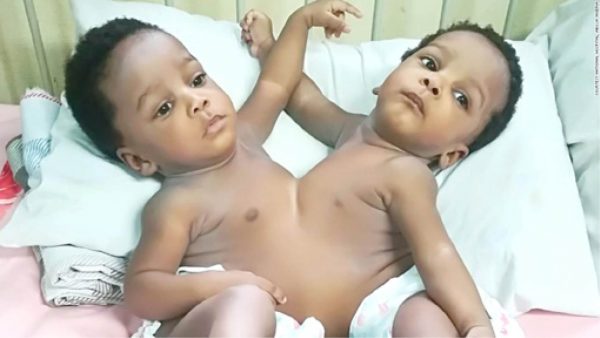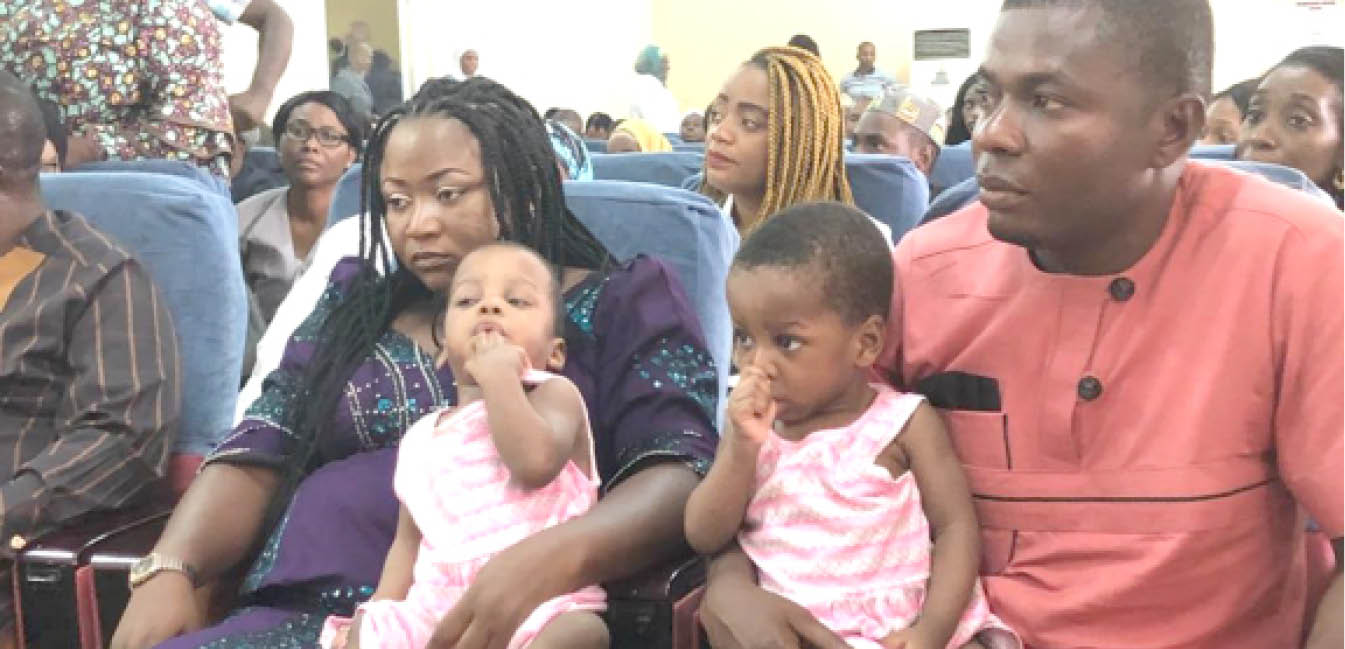Inside Story Of How Twins Joined At The Chest And Abdomen Were Split In Nigeria (Photos)
Posted by Samuel on Sat 07th Mar, 2020 - tori.ng
The twins
In a medical field fraught with challenges, a team of 78 Nigerian doctors successfully separated conjoined twins, Goodness and Mercy, who were joined in the chest and abdomen. Our reporter chronicles how the operation was undertaken, 15 months after the children were born
They are named Goodness and Mercy, like the line from the Christian prayer. And they came together, twins fused at the chest and abdomen. When they were born like this, conjoined, on August 13, 2018, at the Federal Medical Centre, Keffi, Nasarawa State, they were referred to the National Hospital, Abuja.
Their parents, Michael Edeh Martins, a self-employed painter, and Maria Martins, an unemployed housewife, live in a one room apartment with their first daughter and other relatives at Mararaba, a suburb of the Federal Capital Territory (FCT). Despite scans, they had no idea the twins were conjoined, until they were born through caesarean section.
“The scan showed they were twins but did not show that they were conjoined,” Maria Martins said, “I did two scans at the Federal Medical Centre, Keffi and another one outside the hospital.”
Doctors realized something was wrong during birth at the theatre when the whole process was tough, she said.
“I had my first child through caesarean section. The doctors opened the first place to remove the babies but it was still difficult and that left them wondering,” Maria Martins said. “I was not asleep so I was aware of everything they were doing. They later discovered the problem when they widened the tear.”
She recalled feeling unusually heavy during the pregnancy so much that if she was able to move one foot, someone had to pull her to move the other. She could feel the weight of the babies on her lap and, unlike other pregnancies, they were not moving too much in the womb.
“Even going to church was a big challenge. But I continued to have dreams urging me to go to my priest for prayers before delivery. It occurred about five times. I also had another major dream where people gathered at my house for celebration. So when the delivery was getting difficult, I was not scared or worried. At a time in the theatre, it seemed all hope was lost. The doctors didn’t think I will make it out alive. When I couldn’t breathe properly with the oxygen mask, I pulled it off and prayed on myself and the children, and to God be the glory, the caesarean section was successful,” she said.
Her faith gave her the strength and courage to love the children she had birthed and when they were referred to the National Hospital, she laid her hands on them and prayed for them, prayed for a successful separation.
Months later, she has cause to smile. The National Hospital was very supportive and undertook the treatment and surgery at no cost to the Idoma couple.
“From the very day we were referred to the National Hospital, Abuja, they treated us well, no harassment and we didn’t pay a kobo,” Mr Michael Edeh Martins said.
It takes a village…
In the case of Goodness and Mercy, the popular adage that it takes a village to raise a child, or two in this case, seemed to ring true. It took a team of 78 medical staff to separate the twins. The team of paediatrics, plastic and cardiothoracic surgeons and others led by Prof. Emmanuel Ameh, a Consultant Paediatric Surgeon, followed a detailed plan to separate the twins, which culminated on a 12 and a half hour surgery.
According to Dr. Ameh, while most twins previously separated in the country were joined at the abdomen, Goodness and Mercy were joined at the chest and abdomen. It made the task complicated.
“The biggest challenge we have with conjoined twins is when the chest and some aspects of the heart are involved,” he said.
The Martin twins shared a liver, chest wall, diaphragm and pericardium (an organ covering the heart) before they were separated.
Prof. Ameh said they were also born with a condition called omphalocele, a birth defect in which an infant’s intestine or other abdominal organs are outside of the body because of a hole in the navel area. The intestines are covered only by a thin layer of tissue and can be easily seen. This condition had to be tackled before the separation commenced.
“The first thing we did when we received them at the National Hospital, Abuja, was to constitute a multi -disciplinary team,” Dr. Ameh said. “They comprised experts from various specialisations such as paediatric surgeons, cardio-thoracic surgeons, cardiologists, neonatologists, imaging experts, haematologist, pathologists, pharmacists, physiotherapy along with different specialized nurses, pathologists and support staff.
“One of the first challenges we had was that the twins came to us with their intestines popping out from the lower part of their tummy. That is a big problem on its own, but we were able to quickly resolve that. The nurses at the neonatal unit did an excellent job. Their intestines healed within three weeks,” he said.

The twins with their parents
The next step was to check what structures and organs the twins shared to know if they could live independent lives when separated. With detailed imaging, it was discovered that they had two separate hearts but shared a common covering of the heart called pericardium. They shared the lower half of the chest, a diaphragm, and had only one liver but two separate intestines.
Leader of the cardiothoracic team, Dr Ndubuisi Anumenechi, said their concern was separating the two hearts but with excellent studies done by the imaging unit, they were able to confirm that the heart were structurally separate but joined by the same pericardium (covering of the heart).
The plastic surgery team inserted expanders (a kind of balloons) in the skin of the babies to ensure that they had enough skin to cover them after the separation. That procedure alone took four hours.
The lead plastic surgeon, Dr Terna Yahweh, said the tissue expanders were gradually inflated over time. “And by the time of the surgery, we had barely enough skin and tissue to cover the exposed parts and other vital structures without tensions which would have led to increase intra-abdominal pressure with consequent catastrophe.”
On the separation of the liver, Prof. Ameh said, “Every human being can survive with a third of the liver , that is why when we do transplant of the liver, it is just part of it that is transplanted to another person. But for the twins, the size of their liver was actually the size of two livers. We used advanced technology to separate it quickly without them loosing blood.”
The Consultant Cardiothoracic Surgeon said the team had to mobilize extra staff from the Federal Medical Centre, Keffi, with extra support from senior colleagues from Ahmadu Bello University Teaching Hospital, Zaria.
“The surgery started from the abdomen with the separation of the liver and diaphragm, before we separated the thoracic part; post operation one of the babies had a little issue which the physiologist resolved spontaneously,” he said.
For Dr. Maryrose Osazuwa, the team lead of the 12-man anaesthesiologist and four-man anaesthetic technicians, it was a tricky operation.
“Each twin had two dedicated anaesthesia teams working in shifts. Meetings and simulation were done prior to surgery to plan anaesthetic management and to ensure that every team member knew their exact roles and responsibilities. The twins and anaesthetic equipment were also colour coded to avoid mix-ups in theatre,” she said.
All of this buttress what Dr. Ameh said when he disclosed that the team trained and retrained themselves to ensure there were no errors on November 14, 2019, when the children were separated aged 15 months.
Three things accounted for the success of the surgery, Dr. Ameh said: a good team of medical experts, an open-ended support from the hospital management that covered the finances and the material need of the surgery and the trust of the parents.
“They were patient despite the fact that they were in the hospital for a long time, and had to leave other children at home,” he said.
After the success of the operation, he said a long follow up is needed to ensure the twins have a completely normal life.
“We need to ensure nutrition; we still need to do some work on Mercy in the future at the chest wall she used to share with her twin. Plastic surgeons also need to repair the scar on the baby’s tummy in future, you know they are girls,” he said.
He also added that the parents are also in need of financial and other support from the public to be able to care for the children.
Chief Medical Director of the hospital, Dr Jaf Momoh said for the entirety of the 14 months the twins were in the hospital, the hospital covered their expenses because of their compelling circumstances.
“My attention was first drawn to their needs as a result of their inability to meet some of the basic cost of hospital admission. Following the assessment of their social status by the hospital, the family was classified as indigent. Thereafter, the management of the hospital decided to fund the care and the entire processes leading to and including the major surgical procedure for the separation as our corporate social responsibility (CSR). We therefore ensured that lack of funds did not stop these beautiful girls from having the opportunity to enjoy their lives independently,” he said.
The success of the surgery drew praise from the Minister of Health, Dr Osagie Ehanire who said the separation of the twins marked a bold venture into the realm of advanced surgery.
“We have demonstrated confidence in our system, it shows that we have a lot of equipment here and experts that can do advanced surgery. We encourage more hospitals to bring their teams together for professional harmony. It was done by an all Nigerian team in the bid to stem medical tourism,” the minister said.
The case of the successful surgery has given opportunities for some chest thumping and the minister too could not hide his pride.
“These beautiful girls aptly named Goodness and Mercy, and the proud parents, are beneficiaries of a healthcare system when it functions as it is supposed to. The case management team has demonstrated that our health system, even with modest resources, can rise to the highest challenges and offer quality care, to find its position among renowned international hospitals,” he said.
Promises have continued to follow. For instance, the minister of health promised the government will monitor the progress of the twins and assist where needed while the Minister of Women Affairs, Dame Pauline Tallen assured Mrs Maria Martins of employment in the Federal Civil Service.
How much of these promises will be fulfilled is a matter of time. For now, Goodness and Mercy, growing as two independent children will hope they live up to their names.
***
Source: Daily Trust













































